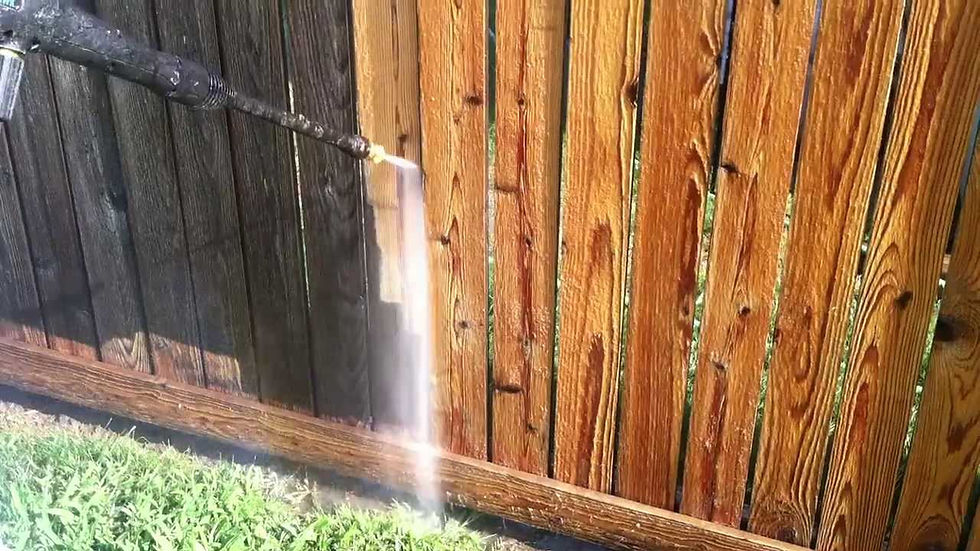Why Your Fence Looks Older Than It Is (And How to Fix It)
- rankorbit831
- Jun 28
- 4 min read

Have you ever pondered how your fence has aged more quickly than the rest of your house? You're not by yourself. Within a few years of installation, many homeowners observe that their once-beautiful fence has become gray, weathered, or unclean. The good news? The things on the fence are often what give the impression that it is getting old, not the fence itself.
This post will explain why your fence may appear older than it actually is and offer doable solutions to make it look younger again. Here is all you need to know, from the effects of weather and neglect to tried-and-true cleaning techniques and upkeep advice.
1. One of the main causes is the weather.
All elements, including sun, rain, wind, and snow, expose your fence to gradual but persistent wear and tear.
UV radiation discolors wood by breaking down its fibers.
Moisture from rain or snow causes mold, mildew, and rot.
Dirt particles that adhere to the surface are carried by wind and dust.
Over time, the material becomes weaker due to expansion and contraction caused by snow and ice.
Without protection, even vinyl or composite fences are susceptible to fading, discoloration, and dirt accumulation.
2. Algae, Mold, and Dirt Build-Up
Dirt is one of the most frequent causes of a fence's aged appearance. Algae, mildew, dust, and filth can adhere to the surface and make it look darker overall. Particularly prevalent in humid or shady locations with little sunlight are mold and algae.
Symptoms of this include:
Black or green stripes
Slimy or slippery areas
faded and dull coloring
In addition to giving the fence an aged appearance, these organisms have the potential to cause structural damage over time.
3. Ignored Upkeep
Let's admit it: people often overlook their fences. They don't require attention until they are in very poor condition, and since they are outside, they are often overlooked. However, one of the main causes of fences deteriorating too quickly is neglect.
Typical maintenance errors consist of
Not doing the annual fence cleaning
Not sealing or renewing timber fences
letting plants (weeds or vines) grow out of control
Ignoring checks for loose or damaged boards
If you haven't performed any of these checks for a few years, your fence is likely showing signs of deterioration.
4. Poor Installation or materials.
Could there be another factor causing your fence to age faster than expected? Longevity was not considered in its construction.
Cheaper materials, whether composed of inferior vinyl, wood, or fasteners, won't withstand stress well. Likewise, improperly placed fences are more prone to premature aging (e.g., posts not buried deeply enough or badly treated).
This could explain why your neighbors' fences continue to look fantastic while yours does not.
5. How to Restore the New Look of Your Fence
The good news is that you can update and restore most ancient-looking fences with a little work. The greatest methods for revitalizing your fence are listed below.
Step 1: Use a pressure washer to clean the fence.
A thorough cleaning is one of the quickest and most efficient ways to revitalize a fence that looks worn out. And pressure washing a fence is the most effective method
What pressure washing eliminates:
accumulated filth and muck
Mold, mildew, and algae
Pollutant or weather-related stains
Old paint or sealant that is peeling (in preparation for restoration)
It's similar to pressing your fence's "refresh" button.
Advice: If you lack experience, get a pro. Improper technique or excessive pressure could harm the wood.
Step 2: Use a New Sealant or Stain
After cleaning and allowing the fence to dry, the next step is to apply a premium stain or sealant. This is beneficial:
Restore a deep, organic hue.
Prevent UV deterioration.
Keep moisture out.
Add years to the lifespan of your fence.
Based on the climate where you live, pick a stain that blends well with your house and offers sufficient protection.
Step 3: Fix Any Damage
Examine the fence for:
loose screws or nails
Warped or fractured boards
Posts or sections that are rotting
Parts of rusted metal
In addition to enhancing beauty, replacing broken parts will guarantee safety and stop more wear.
Step 4: Remove Any Overgrown Plants Near the Fence
Overly near-the-fence plants retain moisture and encourage mold or rot. Regularly trim back vines, trees, and bushes to allow your fence to breathe. This practice also significantly improves the attractiveness of your curb appeal.
Step 5: Plan for Continual Upkeep
Do you want your fence to remain brand-new for many years? Instead of waiting for wear to appear, take preventative measures with regular care:
Once or twice a year, clean
Restain wood every two to three years.
Check for damage in each season.
Regularly trim the vegetation.
Concluding remarks
Your fence shouldn't look old or make your property seem older than it is. A worn-out, shabby fence usually needs a little care. You may have a fence pressure washing that looks new every year with regular maintenance, cleaning, and repair.
Start by assessing the state of your existing fence. A thorough pressure washing may be all that is required to restore a fence that is covered in grime, mold, or fading stains. When you combine that with careful maintenance, your fence can once again be a long-lasting, exquisite feature of your landscape.



Comments